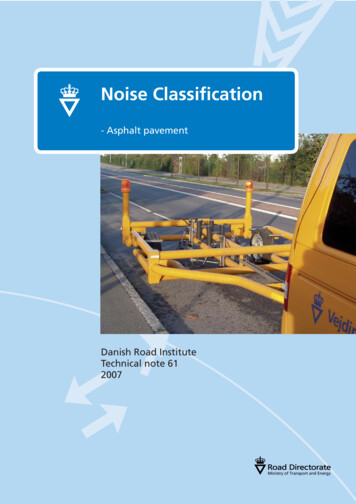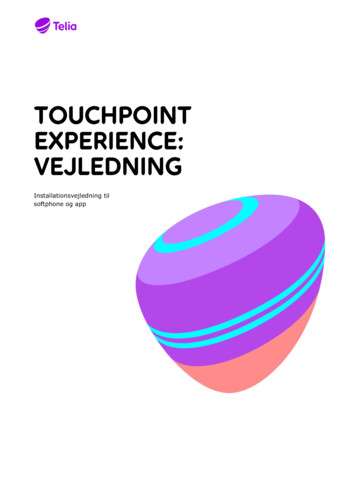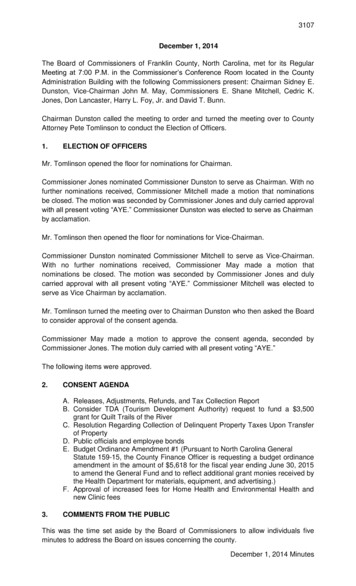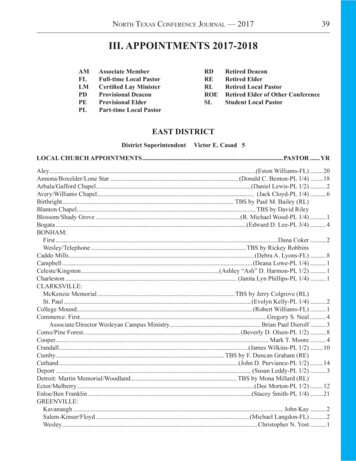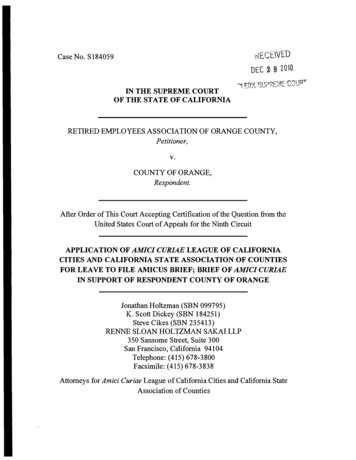
Transcription
ECE\VEDCase No. S184059DEC 2 9 2010IN THE SUPREME COURTOF THE STATE OF CALIFORNIARETIRED EMPLOYEES ASSOCIATION OF ORANGE COUNTY,Petitioner,v.COUNTY OF ORANGE,Respondent.After Order of This Court Accepting Certification of the Question from theUnited States Court of Appeals for the Ninth CircuitAPPLICATION OF AMICI CURIAE LEAGUE OF CALIFORNIACITIES AND CALIFORNIA STATE ASSOCIATION OF COUNTIESFOR LEAVE TO FILE AMICUS BRIEF; BRIEF OF AMICI CURIAEIN SUPPORT OF RESPONDENT COUNTY OF ORANGEJonathan Holtzman (SBN 099795)K. Scott Dickey (SBN 184251)Steve Cikes (SBN 235413)RENNE SLOAN HOLTZMAN SAKAI LLP350 Sansome Street, Suite 300San Francisco, California 94104Telephone: (415) 678-3800Facsimile: (415) 678-3838Attorneys for Amici Curiae League of California Cities and California StateAssociation of Counties
APPLICATION FOR LEAVE TO FILE AMICUS BRIEFTo the Honorable Chief Justice of the California Supreme Court:INTRODUCTIONPursuant to California Rules of Court, rule 8.520(f), amici curiaeLeague of California Cities and California State Association of Countieshereby respectfully request leave to file the attached brief in support ofRespondent County of Orange. This application is timely made within 30days after the filing of the reply brief on the merits.THE AMICI CURIAEThe League of California Cities ("League") is a non-profitassociation of 474 California cities dedicated to protecting and restoringlocal control to provide for the public health, safety, and welfare of theirresidents, and to enhance the quality of life for all Californians. TheLeague is advised by its Legal Advocacy Committee, which is comprisedof 24 city attorneys from all regions of the state. The Committee monitorslitigation of concern to municipalities, and identifies those cases that are ofstatewide - or nationwide- significance. The Committee has identifiedthis case as being of great significance due to its potential impact on manyCalifornia cities and their citizens.The California State Association of Counties ("CSAC") is a non profit corporation. Its membership consists of the 58 California counties.CSAC sponsors a Litigation Coordination Program, which is administered1
by the County Counsels' Association of California, and is overseen by theAssociations' Litigation Overview Committee, comprised of countycounsels throughout the state. The Litigation Overview Committeemonitors litigation of concern to counties statewide and has determined thatthis case is a matter with the potential to affect all California counties.THE INTEREST OF AMICI CURIAEMany members of the League and CSAC (collectively, the "amici ")provide or subsidize in part health benefits for their retired, formeremployees. The resolution of this question will have a direct and profoundimpact on the public agencies thatamici represent, particularly with respectto their budgeting and employment practices. For this reason, theamicihave a substantial interest in the present matter.THE NEED FOR FURTHER BRIEFINGRepresenting the interests of California public agencies,amici areuniquely positioned to explain the legal norms under California lawconcerning the formation, modification, and alleged "vesting" of healthbenefits for retirees. They are also able to explain the practicalramifications on public agencies if this Court were to adopt the argumentsurged by Petitioner in favor of vesting by implication.The League and CSAC are deeply familiar with the legalrequirements and processes by which their members promulgate andadminister legislation, ordinances, and policies. Central to these2
organizations' operations is the understanding of the role of electedofficials in representative democracy at the local leve( Thus,amici seek toilluminate the legal and practical implications of the issue presented here:whether retiree health benefits can vest by implication and without formalapproval of a legislative body.CONCLUSIONFor the foregoing reasons, theamici curiae respectfully request thatthe Court accept the accompanying brief for filing in this case.Dated: December 29, 2010RENNEBy:SLOAN HOLTZMAN SAKAI LLP JvrtJONATHANV:H0LTZMAK. SCOTT DICKEYSTEVE CIKESAttorneys for Amici CuriaeLeague of California Cities andCalifornia State Association of Counties3
CERTIFICATE OF INTERESTED PARTIES[CAL. RULES OF COURT, RULE 8.208]Amici Curiae League of California Cities and California StateAssociation of Counties knows of no entity or person that must be listedunder subsections (I) or (2) of Rule 8.208. (Rule 8.208(d)(3).)4
TABLE OF CONTENTSQUESTION CERTIFIED BY THE COURTINTRODUCTION.ARGUMENTA. . . . . . . . . . . . . . . . . . . . . . . . . . . . . . . . . . . . . . . . . . . . . . . . . . . . . . . . . . . . . . . . . . . . . . . . . . . . . . . . . . . . . . . . . . . . . . . . . . . . . . . . . . . . . . . . . . . . . . . . . . . . . . . . . . . . . . . . . . . . . . . . . . . . . . . . . . . . . . . . . . . . . . . . . . . . . . . . . . . . . . . . . . . . . . . . . . . . . . . .116The Answer to The Ninth Circuit' s Question is No: UnderEstablished California Law, a Cqunty And Its EmployeesCannot Form An Implied Contract That Confers VestedRights to Health Benefits On Employees or Retirees6. . . . . . . . . .1.Legislative Action, Conducted in Compliance WithState Opening Meeting Laws, is Required to ConferAny Rights On California Public Employees. . 6. . . . . . .2.In the Absence of Express Legislative Authorization,Public Employees Cannot Have a "Vested" Right toLifetime Retiree Health Benefits . 93.The CERL Lends Further Support to the Conclusionthat Retiree Health Benefits Do Not Vest AbsentExpress Legislative Authorization. 15. . . . . . . . . . . . . . . . . . . . . . . . .B.REAOC' s Arguments Before this Court Are WithoutMerit. . . . . . . . . . . . . . . . . . . . . . . . . . . . . . . . . . . . . . . . . . . . . . . . . . . . . . . . . . . . . . . . . . . . . . . . . . . . . . . . . . . .1.REAOC's Reliance on You n gma n and OtherAuthorities to Support Its Implied-in-FactContract Theory Is Misplaced. . 17A Vested Right to Lifetime Retiree HealthBenefits May Not Be Implied into aCollectively-Bargained MOU. . . . . . . . . . . . . . . . . . . . . . . . . . .2. . . . . . . . . . . . . . . . . . . . .3. .REAOC Attempts to B lur the DistinctionBetween Non-Vested Health Benefits andVested Pension Benefits. . . . . . . . . . . . . . . . . . . . . . . . . . . . . . . . . . . . . . . . .CONCLUSION17. . . . . . . . . . . . . . . . . . . . . . . . . . . . . . . . . . . . . . . . . . . . . . . . . . . . . . . . . . . . . . . . . . . . . . .CERTIFICATE OF WORD COUNT1212734
TABLE OF AUTHORITIESFederal CasesAdam s v. A vo ndale Indu s ,. Inc . (6th Cir. 1990)905 F.2d 943 . . . . . . . . . . . . . 32Litto n Fi na ncial Pri nti n g Di vi sio n v. NLRB (1991)501 U.S. 190 . 26Ro bert so n v. Kulo n go s ki (9th Cir. 2006)466 F.3d 1114 . . . . . . 24RU I One Corp . v. CityofBer kley (9th Cir. 2004)371 F.3d 1137 . . 19Sa n Die go Police Officer s A s sociatio n v. Sa n Die go City Employee sRetireme nt Sy stem (9th Cir. 2009)568 F.3d 725 . 13, 24, 29So noma Cou nty A s s n. ofRetired Employee s v. So noma Cou nt(N.D. Cal. Nov. 23, 2010), Case No. 09-04432 CW:11/23/2010 Order, DOCKET #51, p. 4 . . . . . . . . . . . . . . . 15, 20Sout her n Cal ifor nia Ga s Co. v. CityofSa nta A na (9th Cir. 2003)336 F.3d 885 . . . . . . . . . . . . . . . . . . . . . . . . . . . . . 23State CasesAm . Fed. ofState, Cou nty & Mu n . Employee s Local 68 v.Cou ntyofLo s A n gele s (1983)146 Cal.App.3d 879 . . . 6A s s n .for Lo s A n gele s Deputy S heriffs v. Cou ntyofLo s A n gele s (2007)154 Cal.App.4th 1536 . . . . . . . . . . 7Ba gley v. CityofMa n hatta n Beac h (1976)18 Cal.3d 22. . . . . . . . . . . . . . . . . . . . . . . . . . . . . . . . . . . . . . . . . . . . . . . . . . . . . . . . . . . . . . . . . . . . . . . . . . . . . . . . . . . . . . . . . . . . .7Cal ifor nia Lea gue of City Employee s A s sociatio n v. Palo s VerdeLi brary A s sociatio n (1978)87 Cal.App.3d 135 . . . . . . . . . . . 29Cal ifor nia Teac her s ' A s s n. v. Cory (1984)155 Cal.App.3d 494 . . . . . 24Carmel Valley Fire Protectio n Di st . v. Cal ifor nia (2001)25 Cal.4th 287 . . . . . 811
CityofEl Cajo n v. El Cajo n Police Officer s' A s s n . (1996)49 Cal.App.4th 64 . . . . . . . . . 25Claypool v. Wil so n (1992)4 Cal.App.4th 646 . . . . . . . . 24, 28Corp . ofAm . v. Dur ham Mutual Water Co . (1942)50 Cal.App.2d 337 . . . . . . . . . . 19Cou ntyofButte v. Superior Court (1985)176 Cal.App.3d 693 . . . 8Cou ntyofRi ver side v. Superior Court (2003)30 Cal.4th 278 . . . . 7Cou ntyofSo noma v. CityofSa nta Ro sa (1894)102 Cal. 426. . . . . . . . . . . . . . . . . . . . . . . . . . . . . . . . . . . . . . . . . . . . . . . . . . . . . . . . . . . . . . . . . . . . . . . . . . . . . . . . . . . . .18Cou ntyofSo noma v. Superior Court (2009)173 Cal.App.4th 322 . . . 8, 18, 27Dimo n v. Cou ntyofLo s A n gele s (2009)166 Cal.App.4th 1276 . . . . . . . . 19, 20Ep stei n v. Hollywood E ntertai nme nt Di st . II (200 1)87 Cal.App.4th 862 . . . . . . 9Fir st Street Plaza Part ner s v. CityofLo s A n gele s (1998)65 Cal.App.4th 650 . . . . . 10, 11G .L. Mezzetta v. CityofAmerica n Ca nyo n (2000)78 Cal.App.4th 1087 . . 10, 11Gle ndale City Employee s A s sociatio n v. CityofGle ndale (1975)15 Cal.3d 328 . . . . . . . . . . . . 21, 22Ka s hmiri v. Re ge nt s of U ni v. of Cal . (2007)156 Cal.App.4th 809 . . . . . . . . . . . . . . . . . 19Ker n v. CityofLo n g Beac h (1947)29 Cal.2d 848 . . . . . . . . . . . . . 28, 31or nia (2000)Kim v. Re ge nt s of U ni ver sityof Cal if80 Cal.App.4th 160 . . . . . . . . . 19Lu ndee n Coati n gs Corp . v. Dept . of Water & Power (1991)232 Cal.App.3d 816 . . . . . . . . . . . . . . . . . 11111
Kemper Ca n st . Co . v. CityofLo s A n gele s (1951)37 Cal.2d 696 . . . . . . . . . . . 18, 19MF.Me ndoci no Cou nty Employee s A s s n . v. Cou ntyofMe ndoci no (1992)3 Cal.App.4th 14872 . . . . . 27Miller v. Cal ifor nia (1977)18 Cal.3d 808 . . 6, 31Miller v. Mc Ki n no n (1942)20 Cal.2d 83 . . . . 10Moore v. Metro . Life In s . Co . (2d Cir. 1988)856 F.2d 488 . . 32Mulla n v. State (1896)114 Cal. 578 . . . 11Ol so n v. Cory (1980)27 Cal. 3d 532 . . . . . . . . . . 28Ream s v. Cooley (1915)171 Cal. 150 . . . . . . 10Sa n Ber nardi no Pu blic Employee s A s sociatio n v. CityofFo nta na (1998)67 Cal.App.4th 1215 . 24,25,26,29Sappi n gto n v. Ora n ge Cou nty U nified Sc hool Di strict (2004) 119Cal.App.4th 954 . . . . . . . 12S hoema ker v. Myer s (1990)52 Ca1.3d 1. . . . . . . . . . . . . . . . . . . . . . . . . . . . . . . . . . . . . . . . . . . . . . . . . . . . . . . . . . . . . . . . . . . . . . . . . . . . . . . . . . . . . . . . . . .19Thor ni n g v. Holli ster Sc hool Di strict (1992)11 Cal.App.4th 1598 . . . . . . . . . 29Tirapelle v. Da vi s (1993)20 Cal.App.4th 1317 . . 6To n ki n Co n structio n Co. v. Cou ntyofHum boldt (1987)188 Cal.App.3d 828 . . . . . . . . . . . . . . . . . . . . . . . . . . . . . . 19Valde s v. Cory (1983) 139 Cal.App.3d 773 . 28Ve ntura Cou nty Retired Employee s A s sociatio n v. Cou ntyof Ve ntura (1991)228 Cal.App.3d 1594 . . . . . . . . . . . 12, 13lV
You n gma n v. Ne vada Irri gatio n Di strict (1970)70 Cal.2d 240 . . . . 18Zottma n v. City & Cou ntyofSa n Fra nci sco (1862)20 Cal. 96. . . . . . . . . . . . . . . . . . . . . . . . . . . . . . . . . . . . . . . . . . . . . . . . . . . . . . . . . . . . . . . . . . . . . . . . . . . . . . . . . . . . . . . . . . . . . .11StatutesGov. Code§ 3500et seq . . . . . . . . . . . . .4, 21Gov. Code§ 3505.1 . . . 5, 7, 22Gov. Code§ 3505.4 . . . 27Gov. Code§ 20000et seq . . . . . . . . . . . . . . . . . . . . . . . . . . . . . . . . . . . . . . . . . . . . . . . . . . . . . . . . . . .30Gov. Code§ 20380 . . . . . . . . 30Gov. Code§ 20382 . 30Gov. Code§ 22009.1 . . . . . . . . . . . . . . 30Gov. Code§ 25300 . . . . . . . . . . 7, 18Gov. Code§ 31450et seq. . . . . . . . . . . . . . . . . . . . . . . . . . . . . . . . . . . . . . . . . . . . . . . . . . . . . . . . . . . . . . . . . . . . . . . .15Gov. Code§ 31691 . . . . . . . . . . . . . 2, 16Gov. Code§ 31692 . . . . . 16Gov. Code§ 31693 . . . . . . . 16Gov. Code § 54950et seq. . . . . . . . . . . . . . . . . . . . . . . . . . . . . . . . . . . . . . . . . . . . . . . . . . . . . . . . . .8Gov. Code § 54953 . . . . . . . . . . . . . . . . . 8Gov. Code§ 54954.1 . . . . . . 9Gov. Code § 54954.2(a) . . . . . . . . . . . 9Gov. Code § 54960.1 . . . . . . . . 9Other Authorities10 McQuillin, Mu n . Corp . (3d ed. 2009),§ 29.2 . . . 11Witkin, Co ntract s (1Oth ed. 2005),§ 980, p. 1096 . . 10Constitutional ProvisionsCal. Const., art. I,§ 3(b ) . . . . . . 9Cal. Const., art. XI,§ 1(b) . . . . . . . . . . . . . . . 18Cal. Const., art. XI,§1(b) . . . . . . . 7Cal. Const., art. XVI,§ 17. . . . . 30v
BRIEF OF AMICI CURIAEQUESTION CERTIFIED BY THE COURTOn August 18, 2010, this Court granted the Ninth Circuit Court ofAppeals' request under Rule of Court 8.548 for an answer to the followingquestion:Whether,as a matter of California law, aCalifornia county and its employees can forman implied contract that confers vested rights tohealth benefits on retired county employees.INTRODUCTIONThe seemingly straightforward question asked by the Ninth Circuitgoes to the heart of an issue that will dramatically affect the long-termviability of many of California's cities and counties. Many cities andcounties provide some form of health benefit program for their retirees.These range in scope from permitting retirees to enroll in a group healthinsurance plan, to payment of 100 percent of the cost of health insurancecoverage for retirees and dependents. The manner in which these programsare authorized also range from the case before this Court - where thegoverning board considered and acted on retiree rates each year - tocollective bargaining agreements, and even to charter provisions. But whatall of these programs have in common is they must be authorized by alegislative act, under the applicable constitutional and statutory framework.One thing that many - if not most - of these programs have incommon is that they have not been set up in the same manner as pension1
benefits. Frequently, there is no "trust" setting out a specific long termpromise. Typically, they are not "funded" as an employee works, in themanner of a pension benefit. Moreover, usually, there has been no publicdebate addressing the long-term cost of the benefit to taxpayers, orconsideration that the benefit is intended to be permanent. Until veryrecently, most of these benefits have been funded on a pay-as-you-go basisby public agencies; as with health care premiums for active employees, thepremiums are paid directly by the public agency in the year the premium isdue. Some benefits, including the benefit at issue in this matter, are enactedunder a statutory framework that even specifies that the benefit is not"vested." (See Gov. Code§§ 31691(a), 39692 ["The adoption of anordinance or resolution pursuant to Section 39691 s hall gi ve no ve sted ri ghtto any member or retired member [to medical benefits]."], emphasis added.)In most cities and counties, a crisis is now brewing because (1) thecost of providing medical benefits has mushroomed, and (2) newaccounting rules adopted by the Government Accounting Standards Board("GASB") require public agencies to conduct an actuarial study of the costof continuing to provide current retiree medical benefits, and to calculatethe Annual Required Contribution ("ARC") to fund the benefit over a 2030 year timeframe. Largely due to the benefit being unfunded and theexpected rate of inflation for medical benefit costs, these benefits oftenhave astronomical costs, including unfunded liabilities which sometimes2
exceed the ability of public agencies to fund. Consequently, publicagencies across the state are attempting to make their benefit structuresmore efficient and more affordable.In this case, Orange County's change from the "pooling"arrangement1 is a model of thoughtful benefits restructuring; other citiesand counties have made or are considering this and other changes, smalland large, including agreements with employee groups to share the cost ofretirement health benefits. The importance of these efforts cannot beoverstated - they will determine whether local governments can continue toprovide an array of services, including critical public safety andinfrastructure services, or become little more than health care providers fortheir employees and retirees.The diversity of factual circumstances through which retiree healthbenefits are provided is an important context for this Court's considerationof the Ninth Circuit's question, which is essentially a pure question of law.The Ninth Circuit asks: "Whether, as a matter of California law, aCalifornia county and its employees can form animplied contract thatconfers vested rights to health benefits on retired county employees."1 As more fully discussed in the parties' briefing, Orange Countypreviously "pooled" employees and retirees in a single plan. Thisarrangement spread the cost of the more expensive retiree medical benefitsacross the entire group, including active employees and retirees, thusartificially inflating employee rates while holding down retiree rates.3
(Emphasis added.) The answer, as a matter of currently settled law, is thatthey cannot - legislative action, conducted in compliance with stateopening meeting laws, is required to confer any rights on California publicemployees. Permitting "implied" commitments in this circumstance wouldundermine the democratic process by imposing long-term obligations ongovernment that were never aired publicly or debated and approved by theelected governing body.Petitioner Retired Employees Association of Orange County("REAOC") predicates its case primarily on the fact that there is a "pastpractice" of setting rates through a "pooling" arrangement that had theeffect of the county and current employees subsidizing the higher cost ofretiree benefits. But nothing in the legislative materials even arguablysupports a promise not to make changes in the program. Thus, REAOC'sposition requires that virtually the entire "agreement" must be based onemployee conduct, with no legislative approval. In other cases, courts willneed to scrutinize legislative pronouncements carefully, asking whatpreci sely is the scope of the obligation undertaken by the governmentagency, and whether there isclear e vide nce that commitment was intendedto remain unchanged for a lifetime. This analysis must be viewed throughthe well-established principle that there is a presumptiona gai n st finding abenefit to be vested, and in favor of finding that it is negotiable under theMeyers Milias Brown Act (Gov. Code§ 3500et seq .).4
Finally, in addressing the Ninth Circuit's question, this Court mustbe cognizant of the strong distinction between benefits that are bargainedand benefits that are vested. Borrowing from federal labor law, the PublicEmployment Relations Board ("PERB") and some courts have recognized"past practices" not expressly approved by governing bodies, placing theobligation on the public agency to bargain these practices away. It isunclear whether this attempt to import private sector principles of contractto government is appropriate since public employment is a creature ofstatute. As the Meyers-Milias-Brown Act states expressly - in recognitionof more than a century of established public law - agreements betweenunions and a public agency "shall not be binding" unless approved by thepublic agency's governing body. (Gov. Code§ 3505.1)This case provides no occasion to cross that bridge. The impact offinding a benefit to be "vested" goes far beyond - and is almost theopposite of- finding a benefit to be bargainable. Vested benefits cannot bechanged unless each individual affected receives a comparable benefit.Hence, they are categorically unbargainable because collective bargainingaddresses the bargaining unit as a whole, and not individual members.Moreover, bargained-for benefits are almost always bargained only for theterm of a collective bargaining agreement, and therefore, can berenegotiated based on the strength of the parties' positions at the bargainingtable.5
Finding a key benefit such as retiree health benefits to be vestedmerely by implication may deprive both the government entity and theemployees' representatives from renegotiating the benefit (at least as tothose for whom the benefit has vested). Such a ruling could have the effectof making both employees and retirees unwitting captives in publicagencies' financial demise.ARGUMENTA.THE ANSWER TO THE NINTH CIRCUIT'S QUESTION ISNO: UNDER ESTABLISHED CALIFORNIA LAW, ACOUNTY AND ITS EMPLOYEES CANNOT FORM ANIMPLIED CONTRACT THAT CONFERS VESTED RIGHTSTO HEALTH BENEFITS ON EMPLOYEES OR RETIREES1.Legislative Action, Conducted in Compliance With StateOpening Meeting Laws, is Required to Confer Any RightsOn California Public EmployeesAs discussed extensively in the County' s brief, in California, theterms and conditions of public employment are governed by statute, notcontract. (Mille r v. Cal ifo rnia (1977) 18 Cal.3d 808, 813; Am . Fed. ofState , Cou n ty & Mu n . Employee s Local 68 v. Cou n tyofLo s A n gele s (1983)146 Cal.App.3d 879, 889 ["the extent of the protected interest orentitlement (i.e., the terms and conditions of employment) is governedpurely by statute"].) Accordingly, courts have recognized that "publicemployees have no vested right to particular levels of compensation andsalaries may be modified or reduced by the proper statutory authority."(Ti rapelle v. Da vi s (1993) 20 Cal.App.4th 1317, 1332-22; A s s n .fo r Lo s6
A n gele s Depu ty S he riffs v. Cou n tyofLo s A n gele s (2007) 154 Cal.App.4th1536, 1548-49 ["the public employee is entitled only to such compensationas is expressly provided by statute or ordinance"].)A public agency's governing body possesses the exclusive,"plenary" authority to set employee compensation levels. (See Cal. Const.,art. XI,§1, subd. (b); Gov. Code§ 25300; Cou n tyofRi ve rside v. Supe rio rCou rt (2003) 30 Cal.4th 278, 285 [recognizing that a county's governingbody "not the state, not someone else," shall provide for the compensationof county employees].) Further, all decisions with respect to employeecompensation must be made through formal legislation (i.e., resolution orordinance), and approved by a maj ority of the public agency's governingbody. (See Gov. Code§ 3505.1 [memorandum of understanding settingemployee compensation not binding until approved by public agency'sgoverning body]; Ba gley v. Ci tyofMa n hatta n Beac h (1976) 18 Cal.3d 22,25 [statutory requirement that memoranda of understanding be approved bygoverning body "reflect[s] the legislative decision that the ultimatedeterminations [with respect to employee compensation] are to be by thegoverning body itself'].)This latter requirement is particularly important given that the settingof employee compensation plays an important part in the governing body'smuch larger role of adopting a budget, which "entails a complex balancingof public needs in many and varied areas with the finite financial resources7
available for distribution among those demands ." (Cou ntyofButtev.Supe rio r Cou rt (1985) 176 Cal.App.3d 693,699.) The requirement thatemployee compensation be set through formal legislation by the publicemployer's governing body ensures that such important financial decisionsrest with the governing body as a whole,as opposed to any singleindividual. (See Ca rmel Valley Fi re Protectio n Di st .v.Cal ifo rnia (2001)25 Cal.4th 287,302 [enacting a budget "is a legislative decision,involvinginterdependent political,social and economic j udgments which cannot beleft to individual officers acting in isolation . "]; Cou ntyofSo nomav.Supe rio r Cou rt (2009) 173 Cal.App.4th 322,344 [only a majority of acounty's governing body may set employee compensation through formallegislative act and allowing compensation levels to be set by any othermeans "would be inconsistent with both longstanding rules of interpretationand established California case law,as well as deeply offensive to basicprinciples of representative democracy"].)Further,in California,legislative decisions with respect to employeecompensation must be made in compliance with state open meeting laws,including the Ralph M. Brown Act (Gov. Code§ 54950et seq .) . TheBrown Act requires all meetings of a local legislative body to be "open andpublic" so members of the public may attend and comment. (Gov. Code§ 54953.) In addition,the California Constitution states that "[t]he peoplehave the right of access to information concerning the conduct of the8
people's business, and, therefore, the meetings of public bodies and thewritings of public officials and agencies shall be open to public scrutiny."(Cal. Const. art. I,§ 3, subd. (b).) These laws ensure that importantdecisions made by government officials, including decisions with respect toemployee compensation, are subject to strict public scrutiny and oversight.2(
IN SUPPORT OF RESPONDENT COUNTY OF ORANGE Jonathan Holtzman (SBN 099795) K. Scott Dickey (SBN 184251) Steve Cikes (SBN 235413) RENNE SLOAN HOLTZMAN SAKAI LLP 350 Sansome Street, Suite 300 San Francisco, California 94104 Telephone: (415) 678-3800 Facsimile: (415) 678-3838 Attorneys for Amici Curiae League of California Cities and California State

